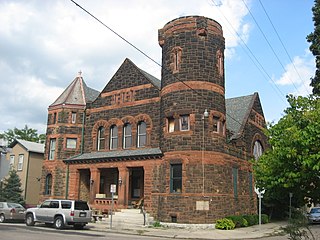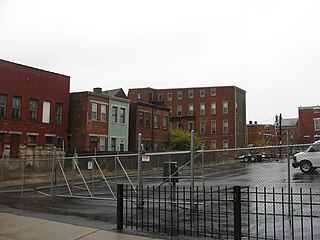
Dayton is a city in and the county seat of Montgomery County, Ohio, United States. A small part of the city extends into Greene County. As of the 2020 census, the city proper had a population of 137,644, making it the sixth-most populous city in Ohio. Dayton anchors the state's fourth-largest metropolitan area, the Dayton metropolitan area, which had 814,049 residents. Dayton is located within Ohio's Miami Valley region, 50 miles (80 km) north of Cincinnati and 60 miles (97 km) west of Columbus. It is a principal city of the Dayton–Springfield–Sidney combined statistical area, home to a population of 1,086,512.

The bicycle business of the Wright brothers, the Wright Cycle Company successively occupied six different locations in Dayton, Ohio. Orville and Wilbur Wright began their bicycle repair, rental and sales business in 1892, while continuing to operate a print shop. These shops helped them fund their aeronautical studies.

Saint Anne's Hill Historic District is part of the Historic Inner East neighborhood in Dayton, Ohio, United States. St. Anne's Hill constitutes a grouping of both vernacular and high style Victorian residences which date roughly from 1860 to the early 20th century. Having originally been platted in 1802 by German immigrants, the neighborhood is significant for its German heritage. Stivers School for the Arts is located within St. Anne's Hill.

Police Station Five was a historic police station in the West End neighborhood of Cincinnati, Ohio. Constructed in the 1890s to serve both regular police and the city's patrol service, it was named a historic site in the late twentieth century, but historic designation was unable to save it from destruction.

The Dayton Arcade is a collection of nine buildings in Dayton, Ohio. The Arcade is a historic, architecturally elegant complex in the heart of Dayton's central business district. Built between 1902 and 1904, it was conceived by Eugene J. Barney of the Barney & Smith Car Company and consists of nine interconnecting buildings topped by a glass-domed rotunda, 70 feet (21 m) high and 90 feet (27 m) in diameter, below which two balconied upper floors circle the central enclave. As president of the Arcade Company, Barney made sure the Arcade had the latest innovations, including elevators, a power plant and a cold-storage plant. The architect was Frank M. Andrews, known also as architect for many of NCR's factory buildings and the American Building at Third and Main Streets in Dayton.

The Commercial Building is a historic skyscraper in central Dayton, Ohio, United States. Constructed in the early twentieth century, it played an important part in the development of the western portion of downtown Dayton, and it is one of the most prominent surviving examples of the work of one of the most significant architects in the city's history. Located at the edge of what was once one of the city's leading commercial complexes, it has been named a historic site.

The Dayton Daily News Building is a historic structure located at the corner of 4th and Ludlow Streets in Dayton, Ohio. It was designed by architect Albert Pretzinger for Dayton Daily News founder James M. Cox. According to Cox's autobiography, he was turned down for a loan by a local banker who told him “Newspapers have never been known to earn money. Of course we can’t accommodate you.” After being turned down for a bank loan to start the paper, Cox asked Pretzinger to "build him a damn bank" so it was modeled after the Knickerbocker Trust building in New York City. Among the most significant components of the three-story building are those surrounding the entrance: three bays wide, the facade features a set of Corinthian columns, a set of fluted columns in the Doric order that form a grand frontispiece around the entrance, and a partial pediment with a cornice supported by cornucopiae. Its walls are built of a mixture of wood and granite.

Sacred Heart Catholic Church is a historic Catholic church building in downtown Dayton, Ohio, United States. Constructed at the end of the nineteenth century for a new parish, it closed in 1996, but was reopened in 2001 when a Vietnamese Catholic group began to use the church. This church building remains significant because of its grand architectural elements, which have led to its designation as a historic site.

The Pretzinger name belongs to a family of architects and engineers in Dayton, Ohio. Albert Pretzinger started the family's architectural legacy.

Schenck and Williams was an architectural firm in Dayton, Ohio. The firm's projects included the Hawthorn Hill home for Orville Wright and his sister and father, the Dayton Young Men's Christian Association Building, and the Engineers Club of Dayton building. The firm's partners were Harry J. Williams and Harry I. Schenck, both 1903 Cornell University graduates and members of the American Institute of Architects Several other Cornell graduates including Nelson J. Bell (1904), Robert E. Schenck (1912), Albert R. Reilly (1914), Wolfe Marcovitch (1915), Leslie L. Lambert (1916), Ernst W. Kurz (1917) and Ellason R. Smith (1917) came to work for the firm.

The Graphic Arts Building is a historic commercial building on the edge of downtown Dayton, Ohio, United States. Built in the 1920s, it long housed the publishing house of a Protestant denomination, and it has been named a historic site.
Miami-Jacobs Career College is a for-profit college with locations throughout Ohio. Miami-Jacobs Career College has locations in several Ohio cities: Columbus, Dayton, Sharonville, Springboro, and Troy. The school offers degrees in nursing, cosmetology, healthcare, accounting, criminal justice, and graphic design.

The Lend-A-Hand Club was located in downtown Davenport, Iowa, United States, along the riverfront. It was listed on the National Register of Historic Places in 1983.

The Silver City Woman's Club is a historic women's club located at 411 Silver Heights Boulevard in Silver City, New Mexico. The club was founded in 1909, and it built its meeting house in 1935–36. Richard Tatsch designed the clubhouse in the Pueblo Revival style, which reflected the region's architectural history. The clubhouse provided two spaces for the club's community activities and private meetings; the former included distributing food to needy families and conducting child welfare inspections on behalf of the state, while the latter included self-improvement courses in music and literature. The women's club has continuously held its activities in the building since its construction; it has also provided a space for community meetings and large events.

The Woman's Club of El Paso was founded in the late nineteenth century, and during that time was the only woman's organization in El Paso, Texas. The Woman's Club also allowed women in El Paso to become involved in community service and activism. The building which is the home for the club is located on 1400 N. Mesa Drive, and was erected in 1916. The club, now a non-profit organization, traces its official origins back to 1894, and continues to provide an "educational and cultural center for its members." The building is registered in the National Register of Historic Places.

The Carrizozo Woman's Club, at 908 Eleventh St., Carrizozo, New Mexico is a woman's club. Its building was constructed in 1939 and was listed on the National Register of Historic Places in 2003.

The Casa Grande Woman's Club Building, at 407 N. Sacaton Street in Casa Grande, Arizona, USA, is an historic women's club building which was listed on the National Register of Historic Places in 1979.

The Glendale Woman's Club was first organized in 1901 as a “Self Culture Club”, the primary aim of the Woman’s Club was self-improvement from a literary standpoint. They raised money for the first library and city parks. In 1898 the lumber company moved to a new two-story office building; Mr. Messenger could no longer manage the library. A library association was formed. The women’s club bought up stock and then assigned members to vote. Mrs. May Catlin Hanson, through club member Mrs. Lafe Myers, donated a building which was placed in park to house the library until a new one could be built. Mrs. Robert Clark and Mrs. J.M. (Mary) Pearson took the lead. Mary took a class on “Library work” in Phoenix to be able to “start it out right.”. By 1907, membership had increased to fifty members and it became impossible to continue meeting in homes, so the group began to think of acquiring its own clubhouse. On February 21, 1912, exactly 1 week after Arizona became the 48th state, the Club was recognized 501c3 non profit corporation with 85 members. The Glendale Woman's Club is a member of the General Federation of Women's Clubs.

The Woman's Club of Topeka was named as an entity in 1916 but has earlier roots. Its building, located just one-half block west of the Kansas State Capitol and completed in 1925, was listed on the National Register of Historic Places in 1982.

The Woman's Club of Olympia was founded in Olympia, Washington, United States, in 1883. It is one of the oldest woman's club on the West Coast. Founding members included Mehitable Elder, Pamela Case Hale, Mary Hartsock, Janet Moore, Phebe Moore, Mary Shelton, Ella Stork, Abbie Howard Hunt Stuart, and Sarah E. Whitney. Its first president, Mrs. A.H.H. Stewart, a college graduate and a veteran of the Women's Club in Boston, was a "driving force" in the club's organization and was known as the "Mother of Women's Clubs" for having founded other clubs, too.




















